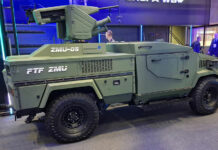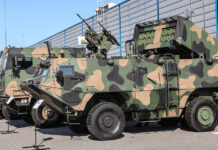Part I – Part II
The biggest investments under the Hellenic government EMPAE multiyear defense program are the construction of six new air-defense frigates, (three are funded in the current multi-year program) as part of a 2.2 billion Euro program. More vessels will be bought to improve coastal defense, and maritime control across the Greek archipelago. These include a command and support landing ship, general support ship, gunboats, fast patrol (missile) boats, mine-hunters, and amphibious assault vehicles. To maintain the Hellenic navy readiness and capabilities until the new frigates are commissioned, the navy is upgrading its existing fleet of 10 “S” class ex-Dutch navy frigates. The first ship to undergo this modernization phase was handed over to the Hellenic Navy on September 12,2006. Six ships will be upgraded until 2009, introducing a modern tactical weapons, communications, navigation and propulsion systems.
The Hellenic Navy ordered four Papanikolis Type 214 submarines from Germany, with the lead ship expected to be delivered soon. Class U 214 submarines are based on construction principles known from U 209. But U 214 was improved by incorporating the innovations of U 212A class, produced for the German Navy, principally the unique air-independent fuel-cell propulsion system. This provides extremely increased underwater endurance.
In February 2000 the Hellenic Navy was the first foreign navy to order fuel-celled U 214 submarines. Greece is already operating eight type 209 submarines; three of them are being refitted with air independent propulsion (AIP) systems, under the Neptune II program. The upgrading program is conducted by the Hellenic Shipyards. Type 214 submarines for the Hellenic Navy will be armed with the WASS (Whitehead Alenia Sistemi Subaquei) Black Shark heavyweight torpedo. The Black Shark is a dual purpose, wire-guided torpedo which is fitted with Astra active / passive acoustic head and a multi-target guidance and control unit incorporating a counter-countermeasures system. It has an electrical propulsion system based on a silver oxide and aluminum battery.
The leading European shipbuilders were prospecting on the new air defense frigate program and its armament suite. These included the German Blohm & Voss, one of the leading contenders for the program, the Dutch Royal Schlede, the producer of the S class frigates, currently in Greek service, and French shipbuilder Armaris, which has proposed Greece to participate in the Franco-Italian FREMM AAW Frigate program. The FREMM is in production for the French and Italian Navies.
While Germany has established its foothold in Greece, producing submarines and investing in local shipbuilding infrastructure, the French consortium has yet to penetrate the local market. Both Armaris and Royal Schelde are also pursuing the Hellenic Navy command and landing support vessel, with platforms previously produced for French, Italian and Dutch navies. As decision on the platform is yet to be made, significant effort is made by the producers of combat systems, primarily air defense missiles, which will be the primary weapons for the new frigates.
Among the naval systems presented by the Russians were the Zubr air-cushion amphibious landing crafts, and the smaller, Project 12061 Murena landing assault air cushion craft. The manufacturer claims that joint employment of the two vessels increases combat manoeuvrability and survivability of naval forces. Russia is also offering its diesel electric powered missile carrying submarines. Two versions are currently offered. Amur-1650 and Amur-950 class submarines. Both can be equipped with the Club submarine-launched cruise missiles. These missiles can be deployed from surface ships (Club N) and submarines (Club S) targeting strategic naval or land-based, radar definable targets which can be defined by their radar signature.

















